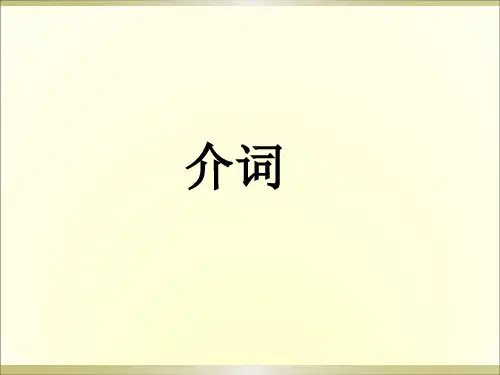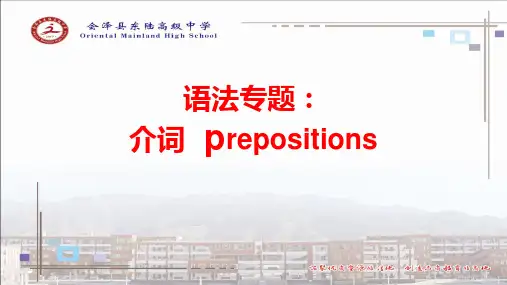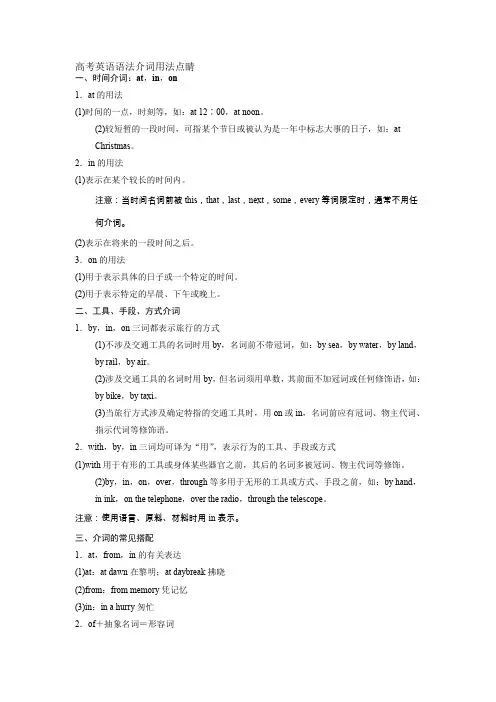高考英语语法考点解读:介词
超实用高考英语复习语法专题:介词

2. The old man died___o_f______ hunger on a cold night.
那位老人饿死在一个寒冷的晚上。
6
3. The little girl's hands turned red___w__it_h____ cold. 小女孩的手冻红了。 4. A number of smokers died __o_f/_f_ro_m____ lung cancer. 许多吸烟者死于肺癌。
9. The theft happened_____a_t____ noon, when all the workers were sleeping.
4
10. Did you witness the traffic accident ___o_n______ a rainy morning?
11. Traffic jams are quite usual ___o_n______ Friday afternoon.
4
19. 直到什么时间用until 20.从过去时间点到现在用介词since
5 表示地点,方向/方位的介词有哪些?
根据汉语提示,填写正确的介词
1. _a_t________ 2. _i_n________ 3. _o_n________ 4. _o_n________ 5. _a_b_o_v_e_____ 6. _o_v_e_r______ 7. _u_n_d_e_r_____
3
介词短语/词组在句中作定语,表语,状语,(主/ 宾)补语,或独立成分。
4 常见表示时间的介词有哪些?
在句中空格上填上适当的介词,并总结其用法规 律
1. What will happen ____i_n_____ the 22nd century?
高考英语语法复习-介词和介词短语

between & among & around A. between 在两者之间 My teacher is sitting between Tom and Mike. 我们的老师正坐在汤姆和麦克之间。 What’s the difference between A and B? B. among 在三者或更多的之中 There is a beautiful house among the trees. 在树林之中有一间漂亮的房子。 He is very popular among the students. 他在学生之中很受欢迎。 C. around环绕,在……周围,在……四周 The earth moves around the sun. 地球围绕太阳转。
on & above & over & under & below
A. on 在……上面,有接触面。 on the desk 在桌子上面 on the map 在地图上 There are two maps on the wall. 墙上有两张地图。
B. above 在……上方 Our plane flew above the clouds. 我们的飞机在云端上飞行。 C. over 在……正上方,是under的反义词 There is a light over Li Ming. 李明的正上方有一盏灯。 A few birds were flying over the sea. 有几只鸟在海上飞。
高考英语语法填空技巧分类突破:介词

短语介词: according to 、 out of 、 because of、 by means of、 in spite of 、 instead of
双重介词 : from behind /above / under , until after
分词介词 :considering , including , judging from /b
8. On 与 about 区别
简单区分:about通俗大众;on学术【专业】性强
on与about 二者都是介词,意为“关于,论及” 等,一般情况下,二者可以互相替换,但二者有 点区别:about常用于简单的或浅显的论述等,是 一般用语,多用于讲故事,谈话;思考等; on多 用于系统论述或专题讲演、论著等,具有学术性, 如:The teacher told us a story about Lei Feng. It's very moving. He will give us a talk on the history of the Party.他将给我们做个关于 党史的报告。
10 表原因的介词:
for , because of , due to , owing to , on account of , as a result of 1. He didn’t come to the meeting ______ his illness 2. The reason ______ his being angry is that he lost his cell phone. 3. ______ a heavy snow , the highway has been closed up. 4. The accident is ______ the driver’s drinking .
2023届高考英语二轮专题复习专题四:介词与介词短语

at happy,pleased,angry,delighted等)连用, He was surprised at the news.
表示产生这种情感的原因
with
常与表示喜、怒、哀、乐等的抽象名词连用 ,强调随着心理变化而产生的情感变化
He
shouted
loudly
with
anger.
from 常接抽象名词,表示自然或间接原因
to 表示两地的相对位置,不接壤 Guangdong is on the east of
in
其后一般接大地方或表示在某个 Guangxi; Fujian lies to the south of
范围之内
Jiangsu and all of them are in China.
off
表示"(时空上)离,距"
3.before, by, until(till)
介词
用法
例句
before 表示"在……之前",与after相对 Please come before ten o'clock.
by 表示"不迟于,在……之前"
I'll have it done by tomorrow.
until (till)
表示"直到……为止",在肯定句 You must wait until/till tomorrow.I
高三语法总复习
专题四 介词和介词短语
By Tiffany
目录
CONTENTS
考点1 介 词 考点2 介词短语及搭配 难点 同一介词所表达的多种含义
考点1 介词
知识1 表示"时间"的介词
高中英语高考语法专题:介词

in
表示在某段较长的时间内(如 世纪、年代、月份等)或泛指
上午、下午、晚上等
in December“在十二月”; in the morning“在上午”
(2)表示时间的 in 和 after
in after
意义
表示“在……时间之内/ 之后”,所在的句中必
须表示将来。
表示“在……时间之 后”,通常“after+时 间段”与过去时连用, “after+时间点”与将
He rowed me over to the other side of the lake.
Cover her over with a blanket.(adv.)
(4)against有“违背,违逆;反对;对……不利;倚;靠;碰撞; 预防;衬托;与…相比”之意。
Vacations help us perform better at work, improve our sleep quality and cushion us against depression.假期能帮助我们在工作中表现得 更好,提高我们的睡眠质量和缓解忧愁。
My father will be back after 3 o’clock.
My father came back here after 3 days/ 3 days after/ 3 days later.
(2) 当时间名词前面被 this, that, last, next, some, every, one…等词限定时,通常不用任何介词。
(3) For + 时间段,用与表示一个动作或行为状态 持续了多久。(并不一定用完成时)
(4) 时间段+ ago/ before
through across over
高考英语语法介词用法点睛

高考英语语法介词用法点睛一、时间介词:at,in,on1.at的用法(1)时间的一点,时刻等,如:at 12∶00,at noon。
(2)较短暂的一段时间,可指某个节日或被认为是一年中标志大事的日子,如:atChristmas。
2.in的用法(1)表示在某个较长的时间内。
注意:当时间名词前被this,that,last,next,some,every等词限定时,通常不用任何介词。
(2)表示在将来的一段时间之后。
3.on的用法(1)用于表示具体的日子或一个特定的时间。
(2)用于表示特定的早晨、下午或晚上。
二、工具、手段、方式介词1.by,in,on三词都表示旅行的方式(1)不涉及交通工具的名词时用by,名词前不带冠词,如:by sea,by water,by land,by rail,by air。
(2)涉及交通工具的名词时用by,但名词须用单数,其前面不加冠词或任何修饰语,如:by bike,by taxi。
(3)当旅行方式涉及确定特指的交通工具时,用on或in,名词前应有冠词、物主代词、指示代词等修饰语。
2.with,by,in三词均可译为“用”,表示行为的工具、手段或方式(1)with用于有形的工具或身体某些器官之前,其后的名词多被冠词、物主代词等修饰。
(2)by,in,on,over,through等多用于无形的工具或方式、手段之前,如:by hand,in ink,on the telephone,over the radio,through the telescope。
注意:使用语言、原料、材料时用in表示。
三、介词的常见搭配1.at,from,in的有关表达(1)at:at dawn在黎明;at daybreak拂晓(2)from:from memory凭记忆(3)in:in a hurry匆忙2.of+抽象名词=形容词(1)of+great/much+抽象名词=very+形容词(2)of+no+抽象名词=not+形容词3.to与情感名词连用,表示“某种行动后产生的感觉”to+one’s+情感名词=to the+情感名词+of sb.介词范例:1.The Scottish girl ________ blue eyes won the first prize in the Fifth Chinese Speech Contest.A.by B.of C.in D.with【答案】选D【解析】句意:那个蓝色眼睛的苏格兰女孩在第五届汉语演讲比赛中获得了第一名。
高考英语_【2019届 二轮】三、介词和介词短语
regardless of
不管,不顾
along with 与……一起
next to
紧挨着
真题链接
1.You wouldn’t think that a few months of exercise in your teens
would be enough
the rest of your life.(2017年11月浙江)
out of sight 看不见
out of reach
够不着
out of order
发生故障
out of breath
上气不接下气
out of control 失去控制
8.其他常考短语
as a result of
因为,由于
far from
远非
for fear of
唯恐
instead of
代替,而不是
There is a small house by the river. 河边有座小屋。
(5)near表示“接近;靠近”。 There is a supermarket near my home. 我家附近有一家超市。
2.between和among (1)between指在两者之间。
I sat down between Sue and Jane. 我在苏和简之间坐下。 (2)among指在三者或三者以上之中。 The teacher was standing among the students. 老师站在学生们中间。
产) Site.
6.The good transportation and easy access
Shanxi province
make it a comfortable trip.
高考高中英语核心语法详解 介词
高考高中英语核心语法详解介词第一节基础知识1. 定义从字“介”上理解,介词是一种媒介,是桥梁,主要用于交代其所连接的前后两部分的关系。
从狭义角度讲,介词也可以说是动词的替身。
介词的用法就是放在名词前面、与名词(称为它的宾语)共同构成一个意义单元、称为介宾短语,当作修饰语使用。
介宾短语可以当形容词或副词使用。
2.介词的分类依据介词后面是否有宾语,分为介系词和介副词。
3.介系词主要是指后面可以接宾语的介词,由此构成介宾短语,介词后面的宾语主要是以名词性质的词来做。
例:in trouble 陷入麻烦on the table 在桌子上Bob is in trouble. 鲍勃陷入麻烦。
A red apple is on the table. 一个红苹果放在桌子上了。
4.介副词后面没有宾语,而是直接当副词使用。
Come in. 进来!The soldier stood up. 那名士兵站起来了。
5. 介副词和介词共同使用Mary went down to the basement. 玛丽去了地下室。
down 是介副词,后面没有宾语、直接修饰动词went;to 是介系词,后接名词词组the basement 当宾语、构成一个介词词组to the basement;went 看作不及物动词,后接介词to,再加宾语the basement;He has gone over to your office.over 是介副词,直接修饰动词has gone;to 是介词,后接名词词组your office 当宾语,构成一个介词词组to your office;gone看作不及物动词,后接介词to,再加宾语your office;第二节介系词在短语层面的应用介系词加宾语构成介宾短语后,主要出现在后修饰位置,其作用是交代中心词与其后的宾语之间的关系。
此时介宾短语也可视为形容词的性质。
例:a.2000 entry into the World Trade Organization2000年加入世贸b.an important earner of foreign exchange 赚取外汇的重要来源c. a boom in exports 出口增长第三节介系词在句子层面的应用1. 前状/后状:With the warm weather, the trees grow very well. 天气暖和,树木生长的很好!Kill two birds with one stone. 一石二鸟/一举两得。
高考英语语法填空常考介词
高考英语语法填空常考介词在高考英语语法填空中,介词是常考点之一,这些介词考点常常是考生们易错易混淆的地方。
下面就对每个介词考点进行详细的解释和扩充,帮助考生们更好地掌握这些介词的使用规则。
1. 表示时间的介词:at:常用于表示具体的时间点,如at 8 o'clock,at noon等。
on:用于表示在某一天或具体的某一天的上下午,如on Monday,on the afternoon of July 4th等。
in:用于表示在某个时间段内,如in the morning,in the afternoon等。
at the beginning of:在...的开始。
at the end of:在...的结尾。
in the middle of:在...的中间。
during:在...期间。
2. 表示地点的介词:at:用于表示在某个具体的地点或位置,如at the bus stop,at home等。
in:用于表示在某个建筑物、城市或较大的地理区域之内,如in the classroom,in Beijing等。
on:用于表示在某物的表面或与某物接触的表面,如on the table,on the ground等。
near:在...附近。
by:在...旁边。
between:在...之间。
in front of:在...的前面。
behind:在...的后面。
3. 表示方式的介词:by:用于表示通过某种方式或手段,如by bus,by phone等。
in:用于表示以某种状态或形式存在,如in English,in writing等。
on:用于表示在某种物体或表面上,如on the wall,on the table等。
4. 表示原因的介词:because of:由于...的原因。
due to:由于...的缘故。
这两个介词都可以用来表示原因,但略有区别。
because of更强调直接原因,而due to更强调因果关系。
高考英语语法复习专项之介词课件
介词误用案例分析
介词选择误用
在表示时间、地点、方式、原因等语境中,不同的介词有着不同的用法, 误用会导致表达不准确。例如:I am interested on music (X),应该改 为I am interested in music(O)。
介词误用案例分析
介词搭配误用
一些词组中的介词是固定的,不可随意更改,如look forward to,be used to等。误用会导致语法不通,不符合英语表达习惯。例如:I am looking forward for your reply (X),应该改为I am looking forward to your reply(O)。
介词填空技巧
多读多练
最后,要多读多练,提高自己的语感和填空技巧。可以通过做题、背诵 课文、阅读英文文章等方式来加强自己的语感和词汇量。
介词在阅读理解中的应用
介词在阅读理解中的应用
01 定位信息 02 表示关系
03 区分意义
介词在阅读理解中的应用
定位信息
在阅读理解中,介词的一个重要作用就是帮助我们定位信息。通过介词 所描述的位置、方向、时间等信息,我们可以更准确地理解文章的内容, 从而更好地回答问题。
介词重复误用
在同一个句子中,重复使用同一个介词,会导致语言重复,影响表达效 果。例如:I went to to the cinema (X),应该改为I went to the cinema(O)。
介词填空技巧
介词填空技巧
01 同义词替换 02 熟记搭配
03 注意动词时态
介词填空技巧
同义词替换
在填空时,可以尝试将介词替换成其同义词,判断哪个更符合语境。例 如,将“on”替换成“upon”或“about”等。
- 1、下载文档前请自行甄别文档内容的完整性,平台不提供额外的编辑、内容补充、找答案等附加服务。
- 2、"仅部分预览"的文档,不可在线预览部分如存在完整性等问题,可反馈申请退款(可完整预览的文档不适用该条件!)。
- 3、如文档侵犯您的权益,请联系客服反馈,我们会尽快为您处理(人工客服工作时间:9:00-18:30)。
介词是英语中最活跃的词类之一。
使用频率相当高,用法多而杂,一个介词可能有多种不同的用法;一个相近的意思又可以用不同的介词表达。
所以在一轮的备考中必须逐一掌握每个高频介词的用法;弄清楚易混介词的用法异同;能够根据具体语境灵活运用介词。
常用介词、易错介词的辨析以及介词固定搭配的考查将是介词考查的主要方向。
一、介词的分类与语法功能介词是虚词,不能单独作句子成分,必须与名词、代词(或相当于名词的其他词类或短语等)构成介词短语,在句中充当一个成分。
介词分为:简单介词,如at,in,for等;合成介词,如within,inside,onto,throughout 等;短语介词,如according to,out of,by means of,in spite of,instead of等;双重介词,如from behind /above /under,until after等;分词介词,如considering,including,judging (from/by) 等。
二、介词的意义1.表示时间的介词(1)in表示“在某一时间段”或“在某一时候”,如用在月、季、份、时代、世纪等时间名词的前面,或用来泛指一天的某一段时间。
in也可以指“在……之后”,表示从说话起的若干时间内。
如:in July/summer//ancient timesThe bus will be here in ten minutes.(2)on表示“在特定的某一天”,也可用于带有修饰语的一天的某个时间段之前。
如:on Saturday, on Saturday morning, on the morning of August 1st(3)at表示“在某一时间点”,或用来表示不确定的时间和短期的假日、时节等。
如:at six o'clock, at Easter(4)over, through (out)两者均指“经过的全部时间”。
如:Stay over the Christmas.(5)for与since:for表示动作或状态延续的全部时间长,为“长达……”之意;since用于指从过去特定的某个时刻到说话时为止的一段时间;含有since时间短语的句子要用完成时,但含有for时间短语的句子不一定要用完成时。
如:I have been there for six years.We have not seen each other since 1993.(6)during指“在……时期/时间内”,必须接表示一段时间的词或词组作宾语。
如:She was ill for a week, and during that week she ate little.2.表示地点的介词(1)above, below,over, under,on, on top of, beneath, underneath: above和below分别表示“高于”和“低于”的意思,不一定指垂直方向上的上下;over和under分别表示垂直方向上的上下或高低;on/on top of和beneath/underneath表示“和表面相接触”意义上的上下。
以上三组介词互为反义词。
如:The temple stands on top of the hill.The pen is beneath the book.There is a lamp on the desk.(2)at, on, in:at指小地点或集会场合;on表示线或面上的位置;in表示在立体、区域或环境内,特别是那些较大,能够容纳相应事物的环境。
如:He works at Peking University.Your radio is on the desk.He's sitting in the sun.(3)between与among:between用来说明“在……两者之间”或“三个以上人或事物中的每两者之间的相互关系”;among用来说明“在……三者以上之间”的相互关系;among可以用来表示没有确定数目的物体之间的相互关系。
如:There is a small river between the two villages.The book is the best among these modern novels.The relations between various countries are very important.3.表示原因的介词。
(1)for常常表示褒贬、奖惩的原因或心理原因。
如:They will reward you for your help.(2)from和out of常常表示动机或原因;through表示消极或间接的原因。
如:He feels weak from lack of sleep.He broke down through overwork.4.表示目的的介词for和to都可以引导目的地。
for表示拟定的接收人或目的,for跟在含有出发或开始意义的动词后,如:leave, set out, start, depart, sail等;to表示实际的接收人或目的,to跟在含有方向性的动词后,如:go, come, run, walk, move, fly, drive, ride等。
如:We have left for Hong Kong.He flew to America via Hong Kong.5.表示“关于……”的介词一般about用于比较随便的谈话或非正式的文体;on用于正式的讲话、著作或报告中;of 用于动词talk, read, know, hear等的后面。
如:What are you talking about?in terms of natural resources6.表示原料的介词of和out of表示制成品的材料仍保持原材料的性质;from表示制成品已失去了原材料的性质。
如:His house was built of brick.He made these toys out of old cigarboxes.Steel is made from iron.7.表示价格的介词at和for都可表示价格,at仅表示价格;for还表示“交换”。
如:Eggs are sold at 95 cents a dozen here.I bought it for five pounds.三、常见的介词搭配1.“介词+名词”型(1)in +名词in advance在前头,事先,预先in case如果,万一in charge 主管,掌管,看管in common 共有,共同,公有in demand 有需要的in doubt 感到疑惑的,难以确定的in effect 实际上,生效in fact 事实上in order 按序,井然有序,情况良好;恰当in progress 进行中in return 作为回报in turn 依次,替换地;相应地,转而in vain 徒劳(2)on+名词on guard在值勤on leave 在休假on holiday 在假on strike 罢工on sale 出售on loan 借贷on+the+名词on the move 在移动,搬迁;离开on the march 在行军on the flow 在涨潮on the increase 正在增加on the go 正在活动,正在奔走on the air 正在广播on the fly 正在飞行(3)beyond +名词beyond one's power 是某人力所不及的beyond praise 夸不胜夸beyond one's reach 够不着beyond description 难以形容beyond words 无法用语言形容beyond doubt 无疑beyond one's understanding 无法理解(4)under +名词under development在发展中under observation 在观察中under test 在测试中under construction 在建设中under examination 在检查(调查)中under consideration 在考虑中under repair 在修理中(5)at +名词at length详细地,长时间at sea 茫然at will 任意地at work 在上班at lunch 在吃午饭at rest 在休息at table 在吃饭at school 上at church 做礼拜at peace 处于和平状态(6)out of +名词out of breath上气不接下气out of balance 失去平衡out of date 过时out of patience 不耐烦out of control 失去控制out of business 破产out of style 过时,不时髦out of the ordinary 不寻常的out of touch 失去联系2.复杂介词型(1)表示原因(通常在句中作状语), 意为“由于,因为”。
because of:表示实际原因(表达一种较强的因果关系);on account of:常用来引述逻辑、理性和事实因素。
(2)表示“除……之外”。
with the exception of=except, except for“除……之外”;apart from (=美式英语中的aside from)是个复合介词,既可表示“除……之外”,相当于except (for), 又可以表示“除……之外,(还,也)”,相当于besides;in addition to“除……之外(还,也)”,相当于besides。
(3)表示“有关,关于”。
concerning=regarding“关于,就……而论,在……方面”;with respect to“关于,就……而言”;as for和as to用于句首时表示“至于”。
(4)表示“在……之前”。
ahead of=in advance of,可表示“(在空间或时间上比某人或某事物)更前,更早”,还可表示“领先,优于”;in front of 多指空间的前后关系,“在……前方”。
(5)表示“支持,赞成”。
in support of 维护,支持,支援;in favor of 可指某人“支持,赞成”,也可指事物“有利于……”。
(6)表示“鉴于,由于;根据,按照”。
in the light of 按照,考虑到in terms of 就……而言,谈到according to 根据;按照in view of 鉴于,因为(7)表示“尽管”。
